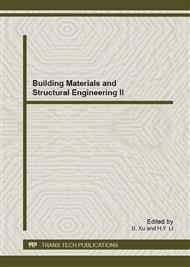[1]
W W Cai, Study on Crack Control by Temperature-control of RCC Dams, Advances in Science and Technology of Water Resources. vol. 20(2), pp.28-30, April 2000. (In Chinese).
Google Scholar
[2]
B F Zhu, Thermal stresses and Temperature Control of Mass Concrete. 2nd ed., Bejing: China Electric Power Press, 1999, pp.8-17. (In Chinese).
Google Scholar
[3]
S W Ji, Y M Zhu, S Qiang and L Guo, Effect of Internal and External Constraints and Creep on Concrete Cracking Stress, Journal of Tianjin University. vol. 42, pp.394-399, May 2009. (In Chinese).
Google Scholar
[4]
B F Zhu, Current Situation and Prospect Temperature Control and Cracking Prevention Technology for Concrete Dam, Shuili Xuebao. vol. 37, pp.1424-1432, December 2006. (In Chinese).
Google Scholar
[5]
G D Schutter, Finite element simulation of thermal cracking in massive hadening concrete elements using degree of hydration based material laws, Computers and Structures. vol. 80(27), pp.2035-2042, (2002).
DOI: 10.1016/s0045-7949(02)00270-5
Google Scholar
[6]
Y M Zhu, Z Q Xu, J R He, et al, A Calculation Method for Solving Temperature Field of Mass Concrete with Cooling Pipes, Journal of Yangtze River Scientific Research Institute. vol. 20(2), pp.19-22, April 2003. (In Chinese).
Google Scholar
[7]
Z Y Zhu, S Qiang, M Z Liu, et al, Cracking Mechanism of Long Concrete Bedding Cushion and Prevention Method, Advanced Materials Research. vol. 163-167, pp.880-887, (2011).
DOI: 10.4028/www.scientific.net/amr.163-167.880
Google Scholar
[8]
Zhu Zhenyang, Qiang Sheng, Zheng Zhanqiang, et al. Dertermination of parameters for hydration exothermic model considering concrete temperature duration by genetic algorithm[J]. Transactions of the Chinese Society of Agricultural Engineering (Transactions of the CSAE), 2013,29(1): 86-92. (in Chinese with English abstract).
Google Scholar
[9]
M Z Liu, S Qiang, Z Y Zhu, Study on crack Mechanism for Concrete Bedding Cushion on Rock, Advanced Materials Research. vol. 163-167, pp.1291-1295, (2011).
DOI: 10.4028/www.scientific.net/amr.163-167.1291
Google Scholar
[10]
M Z Liu, S Qiang, B L Wang, et al, Study on Crack Prevention for Concrete Rapid Construction, Advanced Materials Research, in press.
Google Scholar
[11]
S Qiang, Y M Zhu, G L Zhong, et al, Fast Pouring Method with Thick Layer and Short Interval for Concrete Dam and its Application, Journal of China Three Gorges University(Natural Sciences). vol. 32(4), pp.38-41, August 2010. (In Chinese).
Google Scholar


